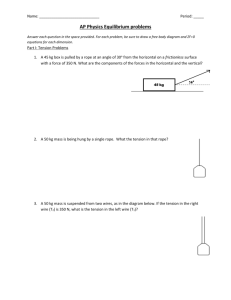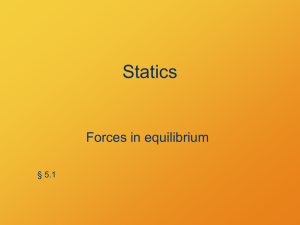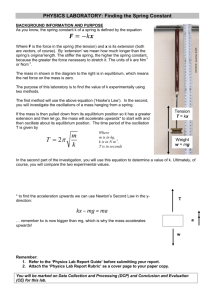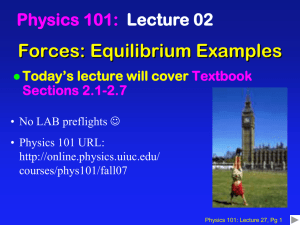Springs & Strings Springs
advertisement
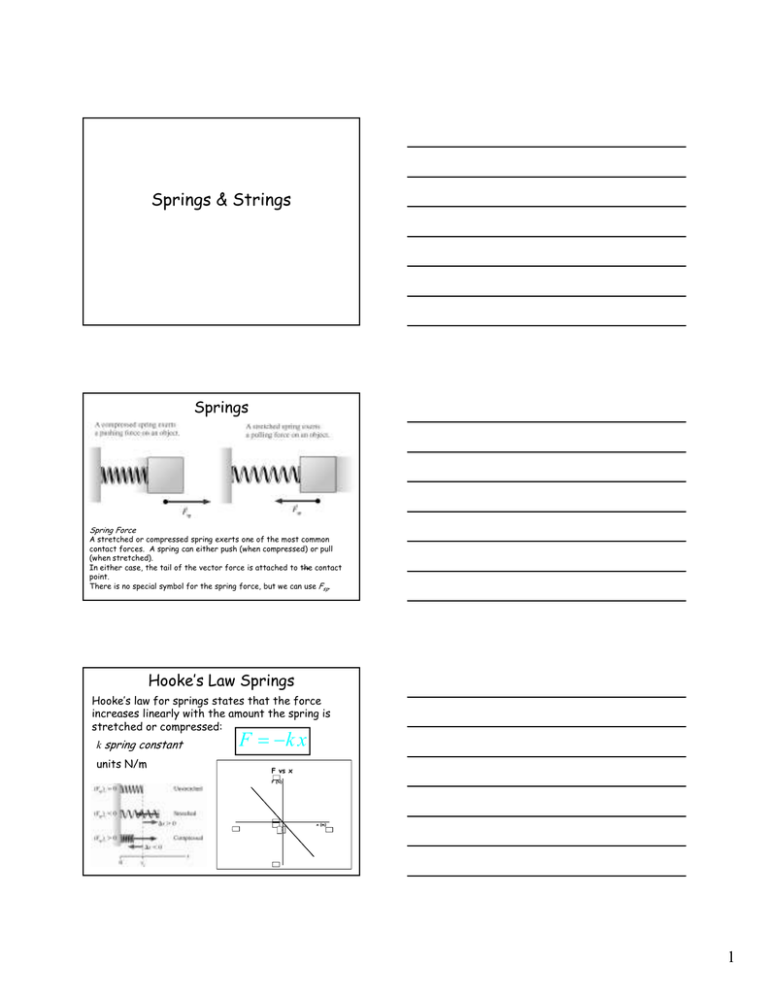
Springs & Strings Springs Spring Force A stretched or compressed spring exerts one of the most common contact forces. A spring can either push (when compressed) or pull (when stretched). In either case, the tail of the vector force is attached to the contact point. There is no special symbol for the spring force, but we can use Fsp. Hooke’s Law Springs Hooke’s law for springs states that the force increases linearly with the amount the spring is stretched or compressed: k spring constant F = −k x units N/m F vs x 5 F (N) 0 -0.3 0 x (m) 0.3 -5 1 Hooke’s Law Springs Hooke’s law for springs states that the force increases linearly with the amount the spring is stretched or compressed. The force is negative because it always opposes the compression or extension of the spring. F = −k x 27•• IP The equilibrium length of a certain spring with a force constant of k = 250 N/m is 0.18 m. (a) What force is required to stretch this spring to twice its equilibrium length? (b) Is the force required to compress the spring to half its length the same as in part (a)? Explain. 0.18 m Tension The tension transmitted by a string, rope, cable, etc. is the force exerted by the string at either end and along its length. 2 Tension The tension in a real rope will vary along its length, due to the weight of the rope. We will assume that all ropes, strings, wires, etc. are massless. So… T1 = T2 = T3 Tension ACT What is the reading in N on each the two spring scales shown above? 9.8 N Pulleys & Tension Ideal pulleys simply change the direction of the tension. There is no friction in the pulley and the pulleys are massless. 3 Tension – Connected Objects When forces are exerted on connected objects, their accelerations are the same. In the situation below, if we know the force and the masses, we can find the acceleration and the tension In addition to the motion of the entire system, we can treat each box as a separate system. Use the entire system to find the acceleration and then use one of the boxes to find the tension. Tension – Connected Objects If there is a pulley, it is easiest to have the coordinate system follow the string. 42. ••• Two buckets of sand hang from opposite ends of a rope that passes over a pulley. One bucket is full and weighs 110 N; the other is only partly filled and weighs 63 N. (a) Initially, you hold onto the lighter bucket to keep it from moving. What is the tension in the rope? (b) You release the bucket and the heavier one descends. What is the tension in the rope now? (c) Eventually the heavier bucket lands and the two buckets come to rest. What is the tension in the rope now? 4 Translational Equilibrium in translational equilibrium, the acceleration is 0 (the velocity is constant (6-5) Tension ACT 2 A B In which situation is the tension on the rope larger? a. A b. B c. Both tensions are the same Equilibrium Tension A 90 kg mountain climber is suspended from ropes as shown. Rope 3 can sustain a maximum tension of 1500 N before breaking. What is the smallest that angle θ can become before the rope breaks? 5
